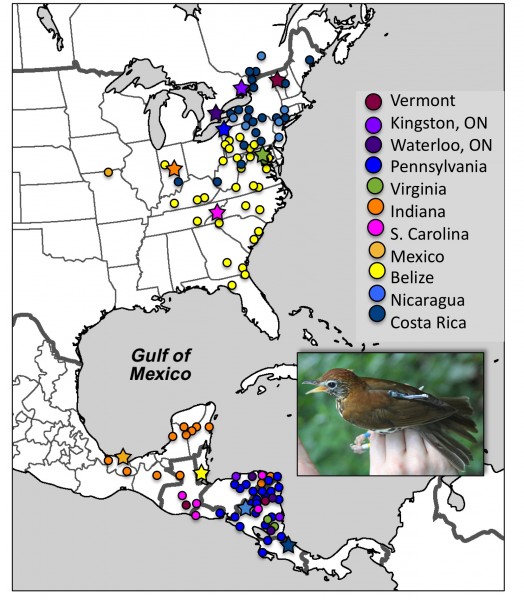TORONTO, July 23, 2014 – Migratory songbirds are disappearing, and though conservationists are examining several possible reasons such as climate change, loss of habitat, acid rain and light pollution, a key piece of the puzzle has remained missing: where do these birds go once they leave their breeding sites, and what threats may they be encountering along the way?
To answer this question, a team of researchers out of York University have created the first ever migratory connectivity map produced for a songbird, using tracking from both breeding and winter sites. They were able to trace the 4,000km route taken by wood thrushes from North America down to Central and South America using bird “backpacks”, tiny geolocators made up of a battery, clock, light sensor, and chip to record data.
“The most challenging thing about these tiny geolocators is that they do not transmit data,” says York U researcher Emily McKinnon. “This means that we put the backpack on the bird, it migrates thousands of kilometres south for the winter, migrates back in spring, and then we have to catch it again to get the data. The culmination of years of this type of tracking, and hours and hours of effort by graduate students, field techs, volunteers, collaborators, and of course our project leader, Dr. Bridget Stutchbury, is detailed migration data from more than 100 wood thrushes tracked from 7 breeding sites and 4 winter sites.”
The team discovered that wood thrushes from Canada don’t migrate to the same areas as their neighbours in Kentucky, Virginia, and the Carolinas, and in fact, have a longer migratory route than their southern counterparts.
“Overall we call this pattern ‘leap-frog’ because the birds breeding the farthest north actually migrate the farthest south, ‘leap-frogging’ over the southern breeding populations,” says McKinnon. “The connections also tended to be predicted by longitude, so that birds breeding further east (and north) spent the winter further east (and south). So if you are Canadian visiting the Mexican Maya Riviera on vacation and you see a few wood thrushes – odds are they are not ‘Canadian’ wood thrushes, but probably birds from the southern US.”
McKinnon says the map shows where each bird goes, and what route it takes to get there, revealing patterns of behavior that will help researchers pinpoint important areas for specific breeding populations. It also reveals that in spring almost 75 per cent of all wood thrushes cross the Gulf of Mexico from the tip of the Yucatan peninsula to land in a small area of Louisiana on the northern gulf coast. That means almost the entire global population of the bird uses that one small area of land near New Orleans every spring.
McKinnon says the map will be helpful to researchers because they will be able to identify and target specific areas for habitat protection. For example, knowing that Canadian wood thrushes overwinter in Nicaragua means that efforts can be made to promote focused conservation in this region, including shade coffee grown under a forest canopy.
“The truth is, they aren’t really Canadian wood thrushes after all,” says McKinnon. “They have dual citizenship!”

Breeding-wintering connections for wood thrushes. Each star is a site where geolocators were deployed on wood thrushes, and the round circles are the birds’ sites in the opposite season. Each deployment location is colour coded. Inset photo shows a wood thrush with a geolocator.
York University is helping to shape the global thinkers and thinking that will define tomorrow. York’s unwavering commitment to excellence reflects a rich diversity of perspectives and a strong sense of social responsibility that sets us apart. A York U degree empowers graduates to thrive in the world and achieve their life goals through a rigorous academic foundation balanced by real-world experiential education. As a globally recognized research centre, York is fully engaged in the critical discussions that lead to innovative solutions to the most pressing local and global social challenges. York’s 11 faculties and 28 research centres are thinking bigger, broader and more globally, partnering with 288 leading universities worldwide. York's community is strong − 55,000 students, 7,000 faculty and staff, and more than 250,000 alumni.
-30-
Media Contact: Robin Heron, Media Relations, York University, 416 736 2100 x22097/ rheron@yorku.ca

